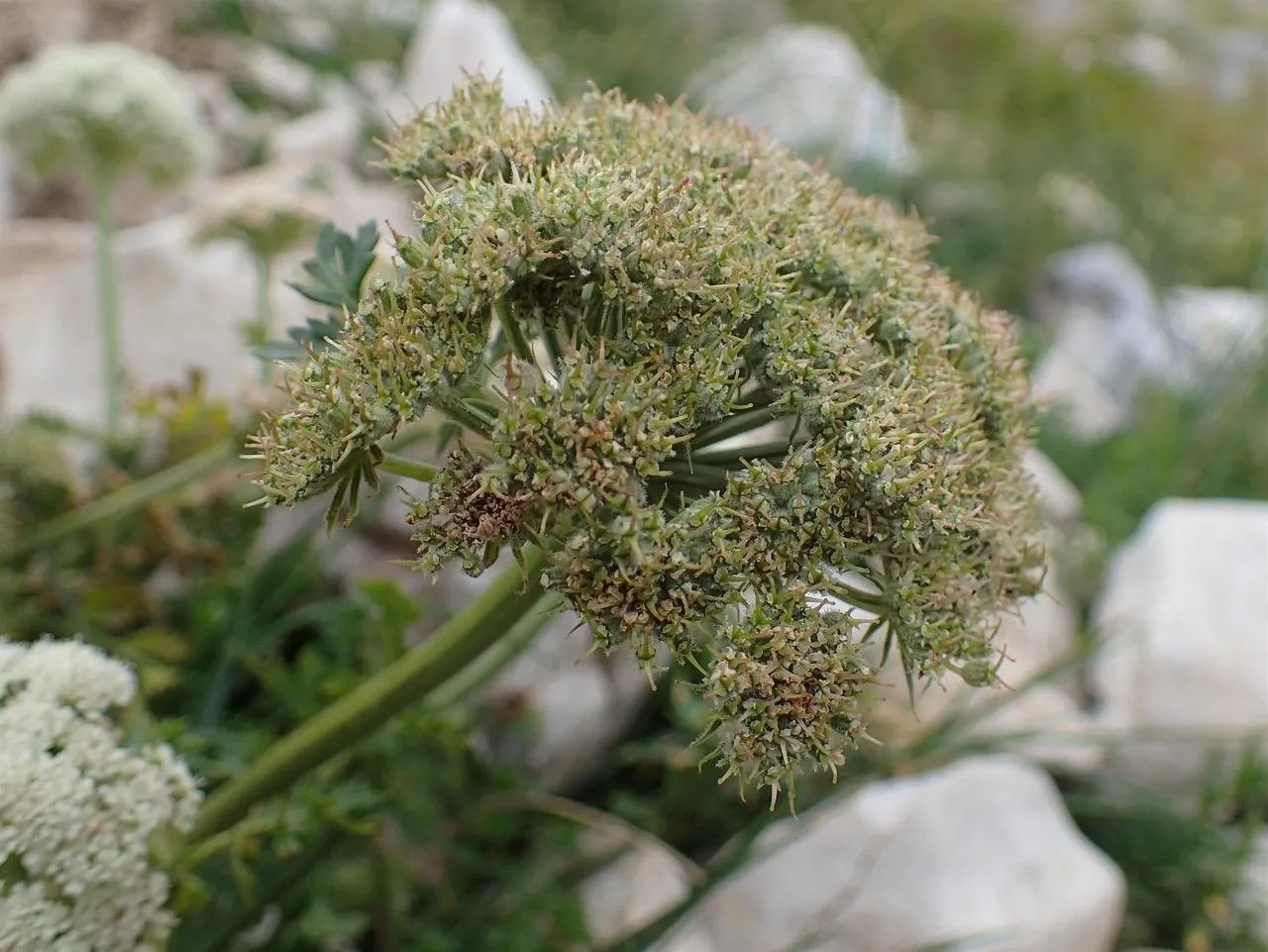
Author: (L.) W.D.J.Koch
Bibliography: Nova Acta Phys.-Med. Acad. Caes. Leop.-Carol. Nat. Cur. 12(1): 111 (1824)
Year: 1824
Status: accepted
Rank: species
Genus: Seseli
Vegetable: False
Observations: Europe to Siberia and NW. & N. Iran
Mooncarrot is a fascinating plant species scientifically known as Seseli libanotis. This resilient herbaceous plant is part of the Apiaceae family, which includes well-known relatives such as carrots, parsley, and celery. Mooncarrot, distinguished by its delicate and intricate floral structures, has a classic charm that makes it an appealing subject for botanists and plant enthusiasts alike.
First identified and classified by the renowned botanist W.D.J. Koch in 1824, the classification was documented in the notable publication “Nova Acta Phys.-Med. Acad. Caes. Leop.-Carol. Nat. Cur.” The species boasts a rich history and a widespread distribution, naturally occurring from the expanses of Europe across to Siberia and reaching as far as Northwestern and Northern Iran.
Mooncarrot thrives in various environments within this vast range, showcasing its adaptability. The plant is generally observed in meadows, grasslands, and by roadsides, where it benefits from open spaces and ample sunlight. It is typically characterized by its umbels of white or pale flowers which bloom in a graceful, spreading arrangement, attracting a variety of pollinators, including bees and butterflies.
The plant’s foliage is equally notable; its leaves are finely divided, giving it a feathery appearance that adds to its aesthetic appeal. These features make Mooncarrot not just a subject of scientific interest but also an ornamental treasure in naturalistic garden settings.
In addition to its visual and ecological appeal, Mooncarrot has also drawn the attention of herbalists for its uses in traditional medicine. Historically, various parts of the plant were used for their supposed medicinal properties, although concrete scientific evidence supporting these uses is limited.
Overall, Mooncarrot stands as a testament to the diversity and adaptability of the Apiaceae family. Its broad geographical distribution and unique botanical features continue to contribute to its intriguing profile within the plant kingdom.
Dan: almindelig hjorterod, hjorterod, hyrdetaske, roset-springklap, småskulpet dodder, sæd-dodder
Deu: berg-heilwurz, feld-sesel, weihrauch-bergfenchel, heilwurz
Swe: bergbräsma, lomme, oljedådra, sanddådra, säfferot
Nor: gjetartaske, oljedodre, rosettkarse, sanddodre
Isl: hjartarfi, lambaklukka
Lav: koch briežsakne
Fin: lutukka, roset-springklap, ruistankio, vehnätankio
Eng: mooncarrot, moon-carrot, moon carrot
Nld: hertswortel
Cym: lloerforon, lloerforonen, moronen y sialc
En: Mooncarrot, Moon-carrot, Moon Carrot
Da: Almindelig hjorterod, Hjorterod, Hyrdetaske, Roset-Springklap, Småskulpet Dodder, Sæd-Dodder
Nl: Hertswortel
Fi: Lutukka, Roset-Springklap, Ruistankio, Vehnätankio
De: Berg-Heilwurz, Feld-Sesel, Weihrauch-Bergfenchel, Heilwurz
Is: Hjartarfi, Lambaklukka
Lv: Koch briežsakne
No: Gjetartaske, Oljedodre, Rosettkarse, Sanddodre
Sv: Bergbräsma, Lomme, Oljedådra, Sanddådra, Säfferot
Cy: Lloerforon, Lloerforonen, Moronen y Sialc
Taken Aug 6, 2017 by Yoan MARTIN (cc-by-sa)
Taken Jun 3, 2017 by Yoan MARTIN (cc-by-sa)
Taken Jun 29, 2022 by Sanne Sanne (cc-by-sa)
Taken Jun 3, 2017 by Yoan MARTIN (cc-by-sa)
Taken Sep 28, 2014 by Tela Botanica − Vivier Emmanuel (cc-by-sa)
Taken Aug 6, 2017 by Yoan MARTIN (cc-by-sa)
Taken Jun 3, 2017 by Yoan MARTIN (cc-by-sa)
Taken Jun 3, 2017 by Yoan MARTIN (cc-by-sa)
Taken Jun 3, 2017 by Yoan MARTIN (cc-by-sa)
Taken Jun 3, 2017 by Yoan MARTIN (cc-by-sa)
© copyright of the Board of Trustees of the Royal Botanic Gardens, Kew.
Taken Jul 5, 2020 by Daniel Bourget (cc-by-sa)
Taken Aug 6, 2017 by Yoan MARTIN (cc-by-sa)
Taken Aug 6, 2017 by Yoan MARTIN (cc-by-sa)
Taken Aug 6, 2017 by Yoan MARTIN (cc-by-sa)
Taken Aug 6, 2017 by Yoan MARTIN (cc-by-sa)
Taken Aug 6, 2017 by Yoan MARTIN (cc-by-sa)
Taken Aug 6, 2017 by Yoan MARTIN (cc-by-sa)
Taken Aug 6, 2017 by Yoan MARTIN (cc-by-sa)
Taken Aug 6, 2017 by Yoan MARTIN (cc-by-sa)
Growth habit: Forb/herb
Family: Myrtaceae Author: (F.Muell.) K.D.Hill & L.A.S.Johnson Bibliography: Telopea 6: 402 (1995) Year: 1995 Status:…
Family: Rubiaceae Author: Pierre ex A.Froehner Bibliography: Notizbl. Bot. Gart. Berlin-Dahlem 1: 237 (1897) Year:…
Family: Sapindaceae Author: Koidz. Bibliography: J. Coll. Sci. Imp. Univ. Tokyo 32(1): 38 (1911) Year:…
Family: Asteraceae Author: A.Gray Bibliography: Pacif. Railr. Rep.: 107 (1857) Year: 1857 Status: accepted Rank:…
Family: Fabaceae Author: Medik. Bibliography: Vorles. Churpfälz. Phys.-Ökon. Ges. 2: 398 (1787) Year: 1787 Status:…
Family: Aspleniaceae Author: (Cav.) Alston Bibliography: Bull. Misc. Inform. Kew 1932: 309 (1932) Year: 1932…